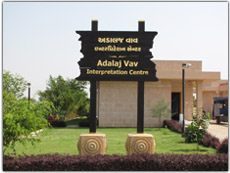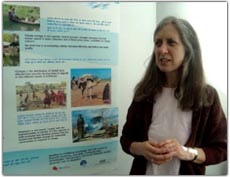|
|
|
Interpreting a Stepwell |
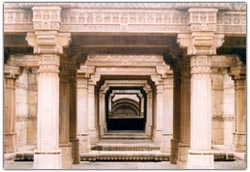 |
|
Stepwells � or stepped wells � are a unique
heritage, especially in the state of Gujarat,
India, which symbolise an amazingly seamless
convergence of ecology, ancient engineering
skills, architecture, sculpture, social cause,
religion and mythology, trade, philanthropy,
stewardship and ruler-ruled relationship. |
Interpretation has been a key thrust area of CEE since
its inception in 1984. CEE's interpretation programmes
seek to convert the visits of people to natural and
cultural heritage sites into an educational
opportunity. They enhance the visitors' experience by
providing on-site information through signages and
exhibits, create a strong impact and go a long way
towards increasing public commitment to the cause of
conservation. Increasingly, interpretation is also
emerging as a vital tool that helps to impress on
visitors the critical link between environment and
sustainable development.
The completion of an interpretation centre at Adalaj
Stepwell 20 km from Ahmedabad is the latest in CEE�s
Cultural Heritage Interpretation. Thousands of people
from villages and towns of Gujarat, from other states
of India, and from abroad visit this stepwell, which
is called Adalaj Vav, in the
small village of Adalaj.
The interpretation facility will offer the many
visitors to the Stepwell a glimpse of its history,
environmental context, architectural and engineering
aspects and, even more important, the two very
significant aspects of the Stepwell � water
conservation and blend of Hindu and Muslim sculpture.
The Interpretation Centre is the result of partnership
between NGO, government and the corporate sector. |
|
|
|
|
|
|
|
Bio
Vision World Life Science Forum |
|
Mr.
Simanta Kalita, Programme Coordinator, CEE North East
and Mr. Ranjit Kumar Mohanty, Programme Coordinator,
Rural Cadre Development, CEE were invited to
participate in the Bio Vision World Life Science forum
organised at Lyon, France. The main theme was �Life
Sciences challenging role in our expanding cities�.
The
conference gathered 3000-4000 participants from across
the world including NGOs, development actors, Nobel
laureates, policy makers, and heads of major
international organisations. A parallel session was
held by Veolia Environment Institute, France under
FACTS Report. The
FACTS Report was initiated by Philippe Kourilsky,
Professor at the College de France in Paris and
Director General of the Pasteur Institute from 2000 to
2005.
The
major objective of the FACTS Reports Conference was to
present, discuss and highlight important, innovative
and highly interesting works from NGOs and
international organisations that help to respond to
some of the key global development and health problems
of the 21st Century.
Mr.
Kalita made a presentation on A journey of
empowering communities for self reliance: Endogenous
Tourism Project in the Governance and
Sustainable Development Projects session, chaired
by Dr. Peter Kearns.
|
|
|
|
|
|
|
Restoration of Village Ponds in Punjab
|
The Punjab
government has invited CEE to devise a strategy for
restoration and sustainable management of degraded
village ponds in selected districts of the State. The
project is an initiative of the Chief Minister Mr.
Parkash
Singh Badal. |
|
|
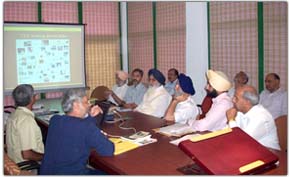 |
|
|
|
A a
concept-level presentation to Chief Minister and
senior state government officials in Chandigarh
was followed by more meetings with state officials and
a rapid appraisal of some proposed villages. |
|
Based on detailed
discussions with the State Government, a pilot-scale proposal
covering nearly 100 ponds in 30 villages of two selected
districts (Muktsar and Mansa) has been approved. CEE's 3-year, comprehensive and focused
intervention will focus largely on social awareness,
attitude and practices-based issues, with some degree of
engineering solutions as more immediate, one-time
demonstration measures in a few locations. A composite
programme will cover awareness & education, capacity
building, and implementation through both social as well as
government-mediated action. Linkages will be built with the
school system through the state-wide programme of Eco Clubs.
Similarly, linkages with NGOs and village-level social groups
will be strengthened for achieving the desired objectives.
The
various administrative requirements are now being followed up,
so that activities at field level may be initiated early. CEE
will set up 2 teams to work in the 2
proposed districts, and a state-level coordination office at
Chandigarh. It is expected that this project will lead to a
revival of ponds in the two districts; a reduction in
pollution and improvement in sanitation conditions; the
formation and strengthening of user groups under Panchayats;
the promotion of participatory solutions with local
involvement; and a revival of village traditions and cultural
practices related to ponds, which have eroded over the years
due to the increasing dissociation of people from their ponds
and other water bodies.
|
|
|
|
|
|
|
Travelling
Exhibition on Gender and Water
The travelling exhibition on Gender and Water for South Asia
titled �Gender and Water: Insights, Innovation and
Transformation� was displayed in
United
Kingdom, Pakistan and Turkey in March.
The travelling exhibition
is made up of seven poster panels with
photographs
depicting issues related to Gender and Water in the South
Asian region. The exhibition will travel to 6 countries:
Bangladesh, Bhutan, India, Nepal, Pakistan and Sri Lanka.
The
exhibition has already been displayed in Sweden,
India and Sri Lanka.
In U.K. the
exhibition was displayed at University of Warwick and Birkbeck
College, London. In Islamabad it was displayed by Aaurat
Foundation, Sungi Foundation and DAAMAN development
organisation. The exhibition will be displayed in Istanbul at
the World Water Conference, by GWA with additional country
panels developed by Pakistan, Nepal and Sri Lanka.
The exhibition has been launched by Gender
and Water Alliance (GWA) in partnership with IW: LEARN (Global
Environment Facility's - International Waters Learning
Exchange and Resource Network) and CEE, Ahmedabad, India. |
|
|
|
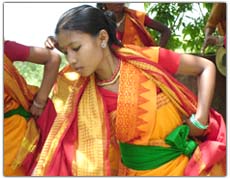 |
|
|
The
presentation highlighted the Endogenous
Tourism Project in general and the processes
of empowering communities in Sualkuchi site
of the Project in particular.
|
|
The
key strategies especially the multi-stakeholder
partnership, community as the decision maker and
converting the process from top-down to bottom-up was
discussed in the presentation. The present status of
the project, community involvement, benefits and
future plans were also highlighted. Rural tourism in
India, with the entire management in the hands of the
community is a new model. There were many obstacles in
setting this new model. These problems in the context
of Sualkuchi site were also discussed in the paper.
Mr. Mohanty presented two papers at the conference.
The first presentation titled Students Grow Their
Own Vegetables in School Yards under
Efficient Responses to The Food
Crisis section based on the CEE�s
experience in Andhra Pradesh on the project aimed to
provide chemical free, nutrient rich vegetables to the
children and to provide an opportunity to learn by
doing. The second presentation titled
Cadre Building for Grass root Governance
was shared under Governance And Sustainable
Development Projects section, focused on the
experience of Samvardhan programme implemented in the
tribal belt of southern Gujarat. The presentation
aimed at presenting cadre building as an alternative
approach to the concurrent rural development scenario.
The outcome of the presentations will be published as
an article in the journal of the FACTS Report. |


